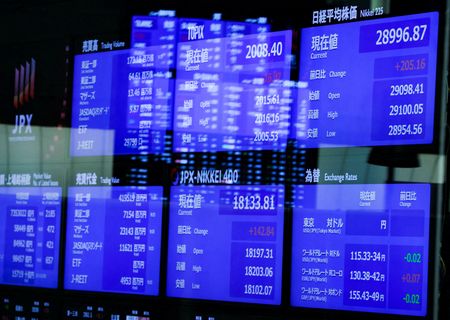
By Amanda Cooper
LONDON (Reuters) -Global shares rose on Monday, but skimmed six-week lows, after another round of data last week forced investors to prepare for higher interest rates in the United States and Europe and there could be more figures to underpin that argument this week.
U.S. manufacturing and services data, as well as a raft of euro zone inflation figures are going to be instrumental in shaping investor expectations for March’s central bank meetings.
There are also at least six Federal Reserve policy makers on the speaking diary this week to offer a running commentary on the likelihood of further rate hikes.
China has manufacturing surveys and the National People’s Congress kicks off at the weekend and will see new economic policy targets and policies, as well as a reshuffling of government officials.
The MSCI All-World index of global shares rose 0.2% on Monday, having posted its largest weekly decline last week since late September, dropping 2.6%, thanks to a sizzling rally in the dollar.
The index is heading for a 3% decline in February, after a rally in January saw many major stock indices post their strongest performance for the first month of the year in years.
January’s euphoria, which was founded on expectations that the major economies will avoid tumbling into recession this year, has given way to something approaching realism about the outlook for interest rates, which are going to rise by more and stay at those levels for longer than many had previously anticipated.
“We’ve had a series of really strong macro data come through and I think that’s just brought this reality check to the market, which had been completely ignoring it and are actually now on the same page as the Fed, which I think is a good thing,” City Index market strategist Fiona Cincotta said.
Fed futures now have rates peaking around 5.42%, implying at least three more hikes from the current 4.50% to 4.75% band, and some chance of 50 basis points in March.
When the Fed concluded its last policy meeting in early February, prior to the release of bumper January employment and business-sector activity data, markets showed traders expected a peak rate of 4.73%, meaning that there’s almost an extra three-quarters of a point now priced in.
U.S. two-year Treasury yields, the most sensitive to shifts in interest-rate expectations, have risen by almost 80 bps in that time, while the S&P 500 has lost 6% in value from Feb. 2’s five-month highs.
STOCKS RECOUP SOME LOSSES
On Monday, European stocks bounced back, thanks to gains across typically rate-sensitive sectors such oil and gas, and technology, which fell 1.4% and 3.8% last week, respectively.
The STOXX 600, which last week lost 1.4%, was up 1.2%. S&P 500 futures rose 0.5%, while those on the Nasdaq futures rose 0.6%.
Economists at UK banks Barclays and Natwest both said they believe the Fed could raise rates by as much as half a percentage point in March, well above the quarter-point that markets currently price in.
It’s not just the United States, where investors believe the central bank will have to keep raising rates to bring inflation back down. Money markets show traders believe the European Central Bank and the Bank of England will have to lift rates to a higher peak and leave them there for longer.
“It does feel a bit more realistic when we’ve got the Fed saying interest rates are going to go higher for longer and we’re seeing that reflected in the markets,” City Index’s Cincotta said.
Bruce Kasman, head of economic research at JPMorgan, has added another quarter-point hike to the ECB outlook, taking it to 100 basis points. Germany’s 2-year bond yield broke above 3.0% on Friday for the first time since 2008.
“The risk is clearly skewed toward greater action from the Fed,” says Kasman.
The dollar has been the main beneficiary of the shift in expectations for Fed rates.
It has risen by 3% this month against a basket of major currencies, which would mark its strongest monthly performance since September, when it hit 20-year highs.
It was last down 0.1% on the day at 105.05, thanks to gains in the pound, which rose 0.4% to $1.1945 and in the yen, which gained 0.2% to trade 136.20, having fallen to its lowest in nine weeks last week, in part due to dovish comments from top policy makers at the Bank of Japan.
Oil shrugged off a potential boost from Russia’s plan to cut supply and the softer dollar. Concerns about the impact to global growth from higher interest rates have knocked about 3.5% off oil prices this year. Brent was last down 0.4% at $84.87 a barrel, while U.S. futures eased 0.2% to $76.16.
(Additional reporting by Wayne Cole in Sydney; Editing by Shri Navaratnam, Sam Holmes, Sharon Singleton and Shounak Dasgupta)

